学术论文英文摘要模板
- 格式:doc
- 大小:44.50 KB
- 文档页数:13

Title:论文题目×××Zhang Qingke1,Yang Bo,Chen Yuehui,Wang lin(作者的隶属单位)Abstract:。
(约250words)Keywords:xxxx;xxxx;xxxx;xxxxxx;xxxxxxxx;xxx;xxxxxxxxxx; (6-7个)1 Introduction写完Results和Discussion,你会对这篇文章内容有着更深入的理解。
这个时候,才回过头写Introduction。
这样做的目的是便于你在Introduction部分提出的一些假设或者预设的问题与Discussion的主要讨论问题前后呼应。
第一段:笼统的介绍该方向研究的意义第二段:综述前人的工作,提出目前的不足或相关的信息,引出该工作的工作动机第三段:根据分析提出某种假设第四段:简单介绍该工作开展的思路,方法,目标,和可能的结论2 Materials and Methods这部分中最好写的。
实事求是地描叙自己的实验材料,实验设计、实验过程、测定方法,数据的采集,分析、计算及其统计方法等。
当然,你也不要一字不漏地描写你的材料与实验过程。
过细,容易造成后面的结果与讨论部分显的单薄,文章整体看上去就会头大身子小,不协调。
过粗,读者看不明白,甚至怀疑你的结果。
因此,这个部分需要有分寸。
原则是主要结果的材料与方法可以偏细,而基本状等次要的部分一笔带过。
实验材料,实验设计,实验过程,数据采集,分析技术及其统计方法。
实事求是地描叙自己的实验材料,实验设计、实验过程、测定方法,数据的采集,分析、计算及其统计方法等。
3 Result在写之前,先列几个subsections,把相对应的图表放进去。
描写一张表或者一副图,第一句应该是交代这个表或者图所表达的主题,然后依次述说。
可以从大到小,可以由特征A到特征B……。
这里需要注意的是条理清楚,重点突出。
一般在Results中,我不喜欢讨论。
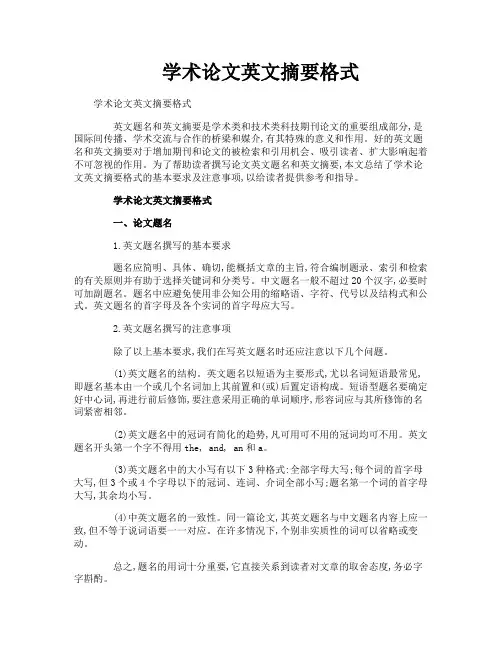
学术论文英文摘要格式学术论文英文摘要格式英文题名和英文摘要是学术类和技术类科技期刊论文的重要组成部分,是国际间传播、学术交流与合作的桥梁和媒介,有其特殊的意义和作用。
好的英文题名和英文摘要对于增加期刊和论文的被检索和引用机会、吸引读者、扩大影响起着不可忽视的作用。
为了帮助读者撰写论文英文题名和英文摘要,本文总结了学术论文英文摘要格式的基本要求及注意事项,以给读者提供参考和指导。
学术论文英文摘要格式一、论文题名1.英文题名撰写的基本要求题名应简明、具体、确切,能概括文章的主旨,符合编制题录、索引和检索的有关原则并有助于选择关键词和分类号。
中文题名一般不超过20个汉字,必要时可加副题名。
题名中应避免使用非公知公用的缩略语、字符、代号以及结构式和公式。
英文题名的首字母及各个实词的首字母应大写。
2.英文题名撰写的注意事项除了以上基本要求,我们在写英文题名时还应注意以下几个问题。
(1)英文题名的结构。
英文题名以短语为主要形式,尤以名词短语最常见,即题名基本由一个或几个名词加上其前置和(或)后置定语构成。
短语型题名要确定好中心词,再进行前后修饰,要注意采用正确的单词顺序,形容词应与其所修饰的名词紧密相邻。
(2)英文题名中的冠词有简化的趋势,凡可用可不用的冠词均可不用。
英文题名开头第一个字不得用the, and, an和a。
(3)英文题名中的大小写有以下3种格式:全部字母大写;每个词的首字母大写,但3个或4个字母以下的冠词、连词、介词全部小写;题名第一个词的首字母大写,其余均小写。
(4)中英文题名的一致性。
同一篇论文,其英文题名与中文题名内容上应一致,但不等于说词语要一一对应。
在许多情况下,个别非实质性的词可以省略或变动。
总之,题名的用词十分重要,它直接关系到读者对文章的取舍态度,务必字字斟酌。
二、论文摘要1.摘要的定义摘要又称概要、内容提要。
摘要是论文主体的高度浓缩,它应该能提炼论文的主要观点,简明地描述论文的内容和范围,简短地进行概括和总结。
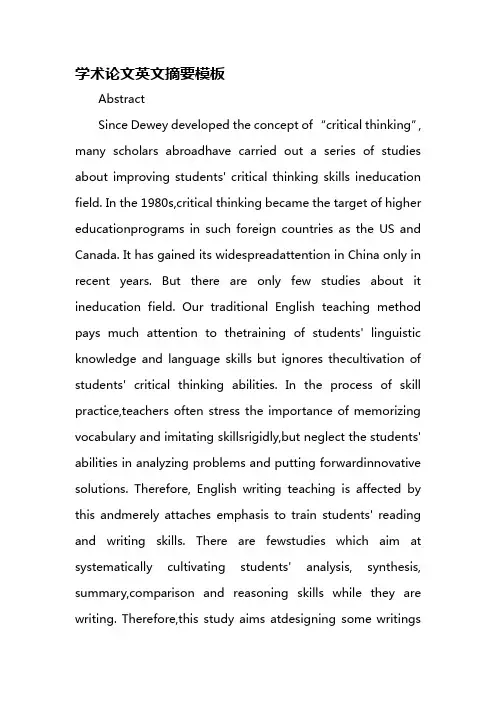
学术论文英文摘要模板AbstractSince Dewey developed the concept of “critical thinking”, many scholars abroadhave carried out a series of studies about improving students' critical thinking skills ineducation field. In the 1980s,critical thinking became the target of higher educationprograms in such foreign countries as the US and Canada. It has gained its widespreadattention in China only in recent years. But there are only few studies about it ineducation field. Our traditional English teaching method pays much attention to thetraining of students' linguistic knowledge and language skills but ignores thecultivation of students' critical thinking abilities. In the process of skill practice,teachers often stress the importance of memorizing vocabulary and imitating skillsrigidly,but neglect the students' abilities in analyzing problems and putting forwardinnovative solutions. Therefore, English writing teaching is affected by this andmerely attaches emphasis to train students' reading and writing skills. There are fewstudies which aim at systematically cultivating students' analysis, synthesis, summary,comparison and reasoning skills while they are writing. Therefore,this study aims atdesigning some writingstasks and teaching strategies which can be used to fostercollege students' critical thinking awareness and promote students' all-rounddevelopment.According to six critical thinking skills,this study was carried out by requiringstudents to hand in an argumentation. All participants in this study are non-Englishmajor college freshmen from a 211 key university. The revised version of Rubric forQualitative Critical Thinking Skills Instrument was used in this study. Withquantitative and qualitative analysis,writing experiment is conducted within a wholesemester to collect data concerning students' learning behavior. Reading-to-write isused in experimental class while traditional method is adopted in control class. Thewriting scores by the experimental and control class were statistically processed bysoftware SPSS 19.0. And also the interview was launched in some of students inexperimental class to assess students' critical thinking abilities reflected in theirwritings-The final analysis indicated that EGAP writing model exerted a significantlypositive influence in improving students' critical thinking skills, especially in arousingstudents' writing enthusiasm and critical thinking awareness. Compared with controlclass, students in experimental class made bigprogress in writing competence. Inaddition, this study put forward some reform proposals to the teaching of Englishwriting. The study is of great value to instruct students to employ critical thinkingskills in their writing.AbstractA large body of research has been conducted on the effects of technology-enhancedEnglish vocabulary learning since the 1960s (Marty, 1981)。
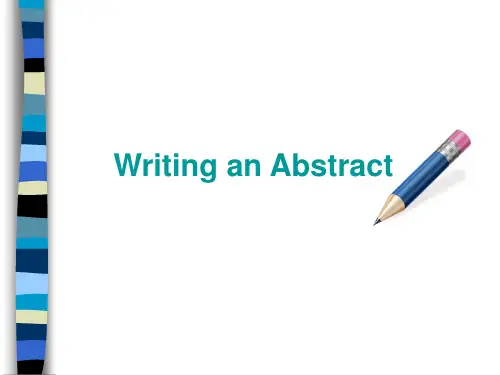
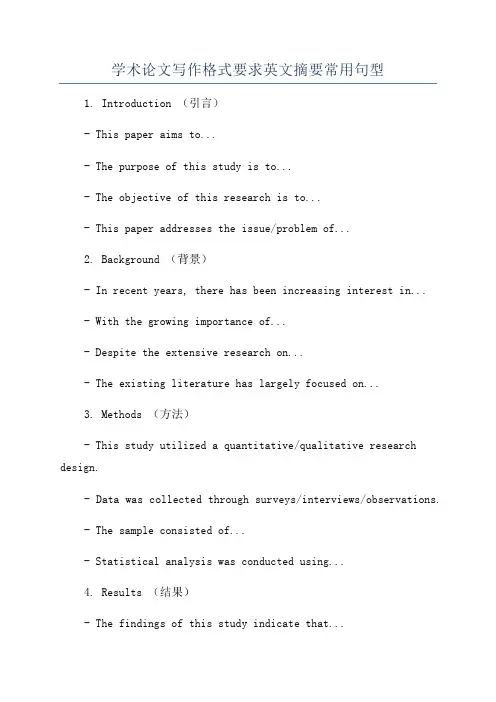
学术论文写作格式要求英文摘要常用句型1. Introduction (引言)- This paper aims to...- The purpose of this study is to...- The objective of this research is to...- This paper addresses the issue/problem of...2. Background (背景)- In recent years, there has been increasing interest in...- With the growing importance of...- Despite the extensive research on...- The existing literature has largely focused on...3. Methods (方法)- This study utilized a quantitative/qualitative research design.- Data was collected through surveys/interviews/observations.- The sample consisted of...- Statistical analysis was conducted using...4. Results (结果)- The findings of this study indicate that...- The results suggest that...- The analysis revealed that...- There is a significant correlation between...5. Discussion (讨论)- These results provide insights into...- The implications of these findings are discussed in terms of...- The present study contributes to the understanding of...- These findings are consistent with previous research in the field of...6. Conclusion (结论)- In conclusion, this study highlights the importance of...- Based on the findings, it can be concluded that...- This study provides valuable information for...- Further research is needed to explore...7. Limitations (限制)- Although this study has provided significant insights, it is not without limitations.- One limitation of this study is the small sample size.- Another limitation is the reliance on self-reported data.- Future research should address these limitations by...8. Implications (意义)- The findings of this study have practical implications for...- These results have important implications for policymakers/practitioners.- The implications of this study extend beyond the specific context of...- This research contributes to the theoretical understanding of...9. Future Directions (未来方向)- Future research should explore...- Further investigation is needed to determine...- Future studies could examine...- This research sets the stage for future research on...。
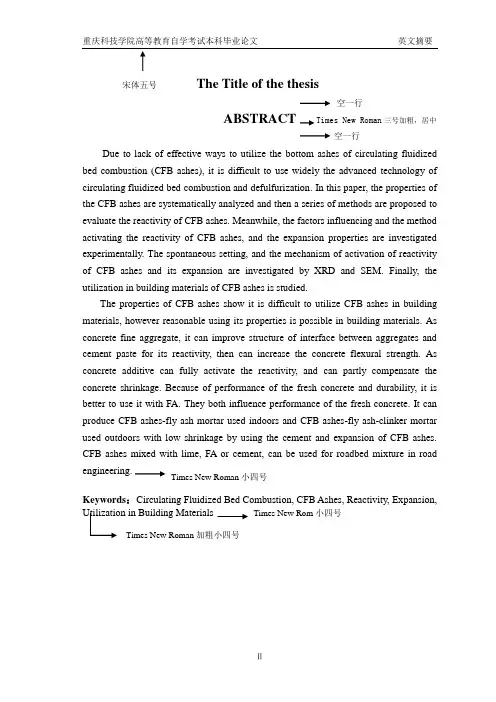
重庆科技学院高等教育自学考试本科毕业论文 英文摘要Ⅱ 宋体五号 The Title of the thesis空一行 ABSTRACT Times New Roman 三号加粗,居中空一行Due to lack of effective ways to utilize the bottom ashes of circulating fluidized bed combustion (CFB ashes), it is difficult to use widely the advanced technology of circulating fluidized bed combustion and defulfurization. In this paper, the properties of the CFB ashes are systematically analyzed and then a series of methods are proposed to evaluate the reactivity of CFB ashes. Meanwhile, the factors influencing and the method activating the reactivity of CFB ashes, and the expansion properties are investigated experimentally. The spontaneous setting, and the mechanism of activation of reactivity of CFB ashes and its expansion are investigated by XRD and SEM. Finally, the utilization in building materials of CFB ashes is studied.The properties of CFB ashes show it is difficult to utilize CFB ashes in building materials, however reasonable using its properties is possible in building materials. As concrete fine aggregate, it can improve structure of interface between aggregates and cement paste for its reactivity, then can increase the concrete flexural strength. As concrete additive can fully activate the reactivity, and can partly compensate the concrete shrinkage. Because of performance of the fresh concrete and durability, it is better to use it with FA. They both influence performance of the fresh concrete. It can produce CFB ashes-fly ash mortar used indoors and CFB ashes-fly ash-clinker mortar used outdoors with low shrinkage by using the cement and expansion of CFB ashes. CFB ashes mixed with lime, FA or cement, can be used for roadbed mixture in road engineering. Keywords : Circulating Fluidized Bed Combustion, CFB Ashes, Reactivity, Expansion, Times New Rom 小四号Times New Roman 加粗小四号Times New Roman 小四号。
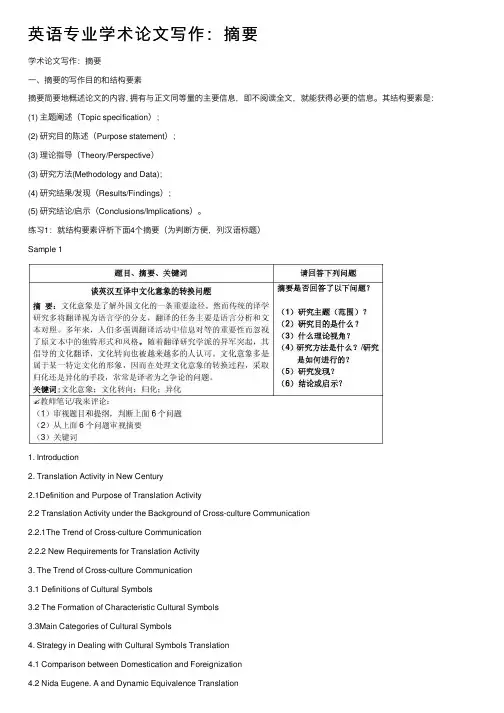
英语专业学术论⽂写作:摘要学术论⽂写作:摘要⼀、摘要的写作⽬的和结构要素摘要简要地概述论⽂的内容, 拥有与正⽂同等量的主要信息,即不阅读全⽂,就能获得必要的信息。
其结构要素是:(1) 主题阐述(Topic specification);(2) 研究⽬的陈述(Purpose statement);(3) 理论指导(Theory/Perspective)(3) 研究⽅法(Methodology and Data);(4) 研究结果/发现(Results/Findings);(5) 研究结论/启⽰(Conclusions/Implications)。
练习1:就结构要素评析下⾯4个摘要(为判断⽅便,列汉语标题)Sample 11. Introduction2. Translation Activity in New Century2.1Definition and Purpose of Translation Activity2.2 Translation Activity under the Background of Cross-culture Communication2.2.1The Trend of Cross-culture Communication2.2.2 New Requirements for Translation Activity3. The Trend of Cross-culture Communication3.1 Definitions of Cultural Symbols3.2 The Formation of Characteristic Cultural Symbols3.3Main Categories of Cultural Symbols4. Strategy in Dealing with Cultural Symbols Translation4.1 Comparison between Domestication and Foreignization4.2 Nida Eugene. A and Dynamic Equivalence Translation4.3 Translation Studies School and Foreignization4.4 Two Strategies in Text Analysis5. Conclusion1. Introduction2. The Rhetorical Motivation in Trade Name2.1 Rational Needs and Rational Needs2.1.1 Rational Needs2.1.2 Emotional Needs2.2 Cultural Factors2.2.1 Ethnic Culture2.2.2 Regional Culture2.2.3 Religious Culture2.2.4 Culture of Place and Person3. The Rhetorical Approaches to Trade Name 3.1 Homophone3.1.1 Homophone in Chinese3.1.2 Homophone between Chinese and English 3.1.3 Homophone in English3.2 Onomatopoeia3.2.1 Emotional onomatopoeia3.2.2 Rational onomatopoeia3.3 Rhyme3.3.1 Alliteration3.3.2 The Ending of Lines of Verse3.3.3 Assonance3.4 Reduplicated Sound4. The Translation of Trade Names4.1 Transliteration4.2 Variant Translation4.3 Phonological and Semantic Combination5. Conclusion附:该论⽂⽬录CONTENTS1. Introduction1.1 Rational and Objective of the Study1.2 Organization of the Paper2.Theoretical Foundation of Verbal Irony Study: A Pragmatic Approach2.1 Description of Verbal Irony2.2 Gricean Perspectives—Irony as Conversational Implicature2.3 Post-Gricean perspective—Irony as Echoic Mentioning3. Verbal Irony and the Responses in Public Debate3.1 Assumptions and Expectations3.2 Introduction to American Public Presidential Debate (APPD) and the Debate Extract Analyzed3.3 Analysis Based on EMT4. Conclusion4.1 Findings in EMT Application—Uncertainty4.1.1 Uncertainty in Identifying Verbal Irony4.1.2 Uncertainty in Justifying the Working Mechanism4.2 Tentative Suggestion—Pragmatics with Lights from the Rhetorical Perspective 4.3 Last Remarks附:该论⽂⽬录CONTENTS1. Introduction1.1Rationale1.2 Literature Review1.3 The Organization of the Thesis2. Theoretical F oundations of D omestication and F oreignization2.1 Domestication and Foreignization2.1.1 Definitions of Domestication and Foreignization2.1.2 Functions of Domestication and Foreignization2.1.2.1 Function of Domestication2.1.2.2 Function of Foreignization2.2 Political News2.2.1 Definition of Political News2.2.2 The Stylistic Features of Political News and Translated PoliticalNews3. Domestication and F oreignization in the T ranslation of P olitical N ews3.1 The Uniqueness of Domestication and Foreignizationin the Translation of Political News3.2 Three Factors Influencing the Choice of Domestication and Foreignization3.2.1 The Translator’s Subjective Factors3.2.2 The Reader3.2.3 The Political Ideology3.3 The Balance of Domestication and Foreignization4. Conclusion⼆、内容的注意事项1. 不要写成⽂献综述(?Sample 1), 也不要说⼈所共知的话(? sample 5)2. 以上结构要素要有具体内容,不要空洞练习2:下⽂是从语⽤顺应理论出发对商务信函写作(sample 5)和商标翻译(Sample 6) 进⾏的研究, 请你(1)删掉⽆关的内容,(2)核对结构要素,(3)并判断哪个内容具体。
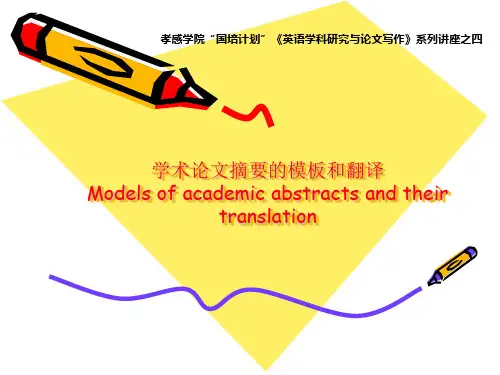
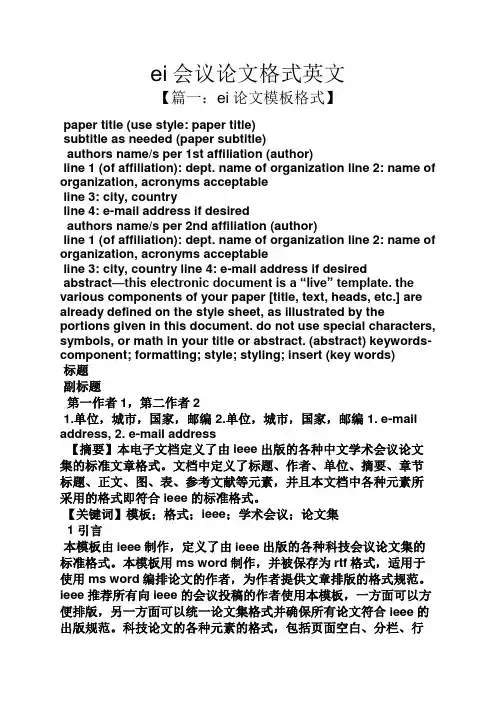
ei会议论文格式英文【篇一:ei论文模板格式】paper title (use style: paper title)subtitle as needed (paper subtitle)authors name/s per 1st affiliation (author)line 1 (of affiliation): dept. name of organization line 2: name of organization, acronyms acceptableline 3: city, countryline 4: e-mail address if desiredauthors name/s per 2nd affiliation (author)line 1 (of affiliation): dept. name of organization line 2: name of organization, acronyms acceptableline 3: city, country line 4: e-mail address if desiredabstract—this electronic document is a “live” template. the various components of your paper [title, text, heads, etc.] are already defined on the style sheet, as illustrated by the portions given in this document. do not use special characters, symbols, or math in your title or abstract. (abstract) keywords-component; formatting; style; styling; insert (key words)标题副标题第一作者1,第二作者21.单位,城市,国家,邮编2.单位,城市,国家,邮编 1. e-mail address, 2. e-mail address【摘要】本电子文档定义了由ieee出版的各种中文学术会议论文集的标准文章格式。
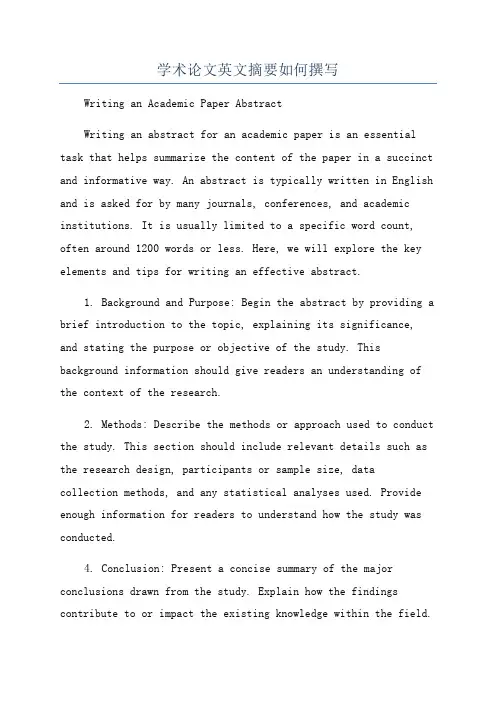
学术论文英文摘要如何撰写Writing an Academic Paper AbstractWriting an abstract for an academic paper is an essential task that helps summarize the content of the paper in a succinct and informative way. An abstract is typically written in English and is asked for by many journals, conferences, and academic institutions. It is usually limited to a specific word count, often around 1200 words or less. Here, we will explore the key elements and tips for writing an effective abstract.1. Background and Purpose: Begin the abstract by providing a brief introduction to the topic, explaining its significance, and stating the purpose or objective of the study. This background information should give readers an understanding of the context of the research.2. Methods: Describe the methods or approach used to conduct the study. This section should include relevant details such as the research design, participants or sample size, datacollection methods, and any statistical analyses used. Provide enough information for readers to understand how the study was conducted.4. Conclusion: Present a concise summary of the major conclusions drawn from the study. Explain how the findings contribute to or impact the existing knowledge within the field.Highlight the significance of the study and its implications for future research or practical applications.5. Keywords: Include a list of relevant keywords at the end of the abstract. Keywords provide a way for readers to easily find your paper when searching for related topics or content. Choose keywords that accurately reflect the focus and subject matter of the study.Tips for Writing an Effective Abstract:1. Be concise: Use clear and concise language to convey the purpose, methodology, results, and conclusions of the study. Avoid unnecessary details or jargon that may confuse readers.2. Use active voice: Write in an active voice to make the abstract engaging and direct. This helps in clearly stating the main findings and conclusions.4. Follow the guidelines: Make sure to adhere to thespecific guidelines provided by the journal or conference for abstract length, formatting, and structure. Failure to follow these guidelines may result in an abstract being rejected.6. Seek feedback: Have someone familiar with the topic or the field review and provide feedback on the abstract. They can help ensure that the abstract is accessible and understandable to a broader audience.。
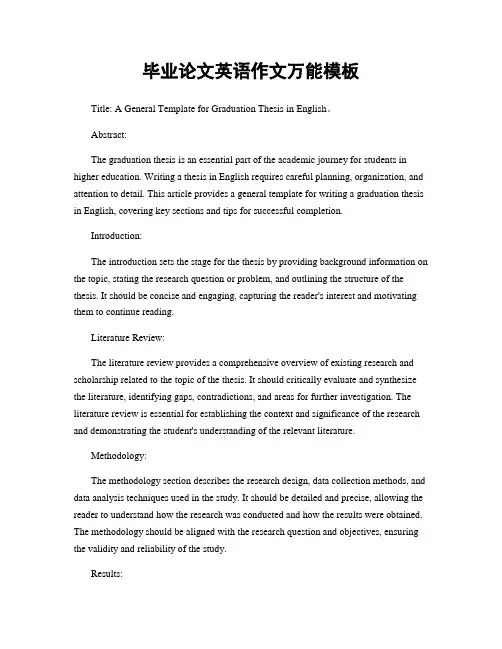
毕业论文英语作文万能模板Title: A General Template for Graduation Thesis in English。
Abstract:The graduation thesis is an essential part of the academic journey for students in higher education. Writing a thesis in English requires careful planning, organization, and attention to detail. This article provides a general template for writing a graduation thesis in English, covering key sections and tips for successful completion.Introduction:The introduction sets the stage for the thesis by providing background information on the topic, stating the research question or problem, and outlining the structure of the thesis. It should be concise and engaging, capturing the reader's interest and motivating them to continue reading.Literature Review:The literature review provides a comprehensive overview of existing research and scholarship related to the topic of the thesis. It should critically evaluate and synthesize the literature, identifying gaps, contradictions, and areas for further investigation. The literature review is essential for establishing the context and significance of the research and demonstrating the student's understanding of the relevant literature.Methodology:The methodology section describes the research design, data collection methods, and data analysis techniques used in the study. It should be detailed and precise, allowing the reader to understand how the research was conducted and how the results were obtained. The methodology should be aligned with the research question and objectives, ensuring the validity and reliability of the study.Results:The results section presents the findings of the research in a clear and organized manner. It should include tables, figures, and other visual aids to support the presentation of data. The results should be reported accurately and objectively, without interpretation or speculation. The results section is crucial for demonstrating the student's ability to analyze and interpret data and draw meaningful conclusions.Discussion:The discussion section interprets the results in relation to the research question and objectives, addressing their implications, limitations, and potential applications. It should also compare the findings with previous research and theory, highlighting their significance and contributing to the advancement of knowledge in the field. The discussion should be logical, coherent, and persuasive, providing a compelling argument for the conclusions drawn from the research.Conclusion:The conclusion summarizes the key findings and insights of the thesis, emphasizing their significance and relevance. It should restate the research question and objectives, review the main points of the thesis, and offer suggestions for future research. The conclusion should leave a lasting impression on the reader, reinforcing the value and impact of the research.References:The references section lists all the sources cited in the thesis, following a specific citation style (e.g., APA, MLA, Chicago). It should be accurate and consistent, providing the necessary information for readers to locate and verify the sources.Tips for Successful Completion:Start early and plan ahead to allow sufficient time for research, writing, and revision.Seek feedback from professors, advisors, and peers to improve the quality of the thesis.Use clear and concise language, avoiding jargon and excessive technical details.Follow the guidelines and formatting requirements of the institution for the thesis.Proofread and edit the thesis carefully to eliminate errors and improve readability.Conclusion:Writing a graduation thesis in English is a challenging but rewarding endeavor that showcases students' knowledge, skills, and creativity. By following the general template and tips provided in this article, students can effectively structure and complete their theses, contributing to their academic and professional development.。
附件1:英文版学术论文格式样张The Researches on Rs Method for Discrete Membership Functions(空一行)ZHANG Xiaoya, LI Dexiang(题目14号字加黑居中) School of Management,Sichuan University, P.R.China, 610036 (10 号字居中)yuanfengxiangsheng@(10号字加黑) (空一行)Abstract Mizumoto used to advance a fuzzy reasoning method ,Rs,which fits the……Key words IDSS,Fuzzy reasoning,……(10号字)(空一行)1 Introduction (一级标题12号字加黑)We know that the approaches of implementation of intelligent decision support systems(IDSS)have become variable……(正文均用10号字)(空一行)2 An ExampleAccording to the definition of Rs,we can construct the fuzzy relation matrix,as shown in table 1Table 1 A Fuzzy Relation Rs (9号字加黑居中) U2U3U10.00 0.10 0.40 0.70……0.00 1.00 1.00 1.00 1.00 ……0.20 0.00 0.00 1.00 1.00 ……(表中用9号字).….. …………………(空一行)Figure 1 Functions of……(9号字加黑居中)3 The Improved Method(空一行)3.1 Method one (二级标题10号字加黑)…………3.1.1 Discussing about method one (三级标题10号字)…………(空一行)3.2 Method two……………………(空一行)4 Conclusion (12号字加黑)…………(空一行)References (12号字加黑居中)(空一行)[1] M.Mizumoto,H.J.Zimmermann. comparision of fuzzy reasoning methods. Fuzzy Sets andSystems ,8(1982),p253~283 (参考文献均用10号字)国际会议论文排版要求及样张关于论文1.论文的书写顺序时:标题、作者姓名、作者单位,邮箱,摘要、关键词、引言、正文、结论、参考文献。
毕业论文英文摘要格式关于《毕业论文英文摘要格式》,是我们特意为大家整理的,希望对大家有所帮助。
一、页面设置与字体毕业论文须用A4纸打印,上为2.5cm,下为2.8cm,左、右均为2.4cm,页码插入页面底端右侧。
除另有特殊规定外,英文一律用Times New Roman,中文一律用仿宋_GB2312.二、毕业论文组成毕业论文由以下几部分组成:论文封面、题目扉页、论文题目、摘要及关键词、正文、参考文献、附录(可选)。
三、毕业论文格式与撰写要求(一)论文封面采用学校统一的封面。
(二)题目扉页参照附件1.(三)论文题目段前段后各1.5行,三号字加粗居中,字体:Times New Roman.题目应该简短、明确、有概括性,字数适当。
题目中所有实词首字母大写。
副标题:四号字,居中,前面加破折号。
(四)中英文摘要及关键词 英文摘要及关键词在前,中文摘要及关键词在后,单倍行距,顶格,五号字。
英文摘要及关键词:字体采用Times New Roman,标示语“Abstract”、“Key words”及冒号加粗。
中文摘要及关键词:标示语“摘要”、“关键词”及冒号为黑体;内容字体为仿宋。
英文摘要一般为60-90英文单词,内容应包括论文研究目的、研究方法、研究结论及论文结构等。
中文摘要及关键词应与英文摘要及关键词相对应。
关键词是表述论文主要内容和信息的词语或术语,关键词数量一般为3-5个。
关键词之间须用逗号隔开,最后一个关键词后不用标点符号。
摘要和关键词中出现英文书名用斜体,出现中文书名加书名号。
(五)正文 1、排版 字号:小四 行距:固定值20磅段落:首行缩进2字符2、篇幅 4000-4500英文单词。
竭诚为您提供优质文档/双击可除icems,20XX,摘要,提交模板,国际会议篇一:国际会议论文摘要中英文格式附件2国际会议论文摘要中英文格式国际针灸学术交流研讨会论文摘要表(中文)主要作者资料称呼:教授/博士/医生/先生/小姐/其他姓:名:通讯地址:城市:州/省:国家:邮区编号:电话号码:手机号码:传真:电子邮箱:单位:是否要求会议发言:worldconferenceonacupunctureabstRactFoRm–completeinenglishdate:论文要求:1、论文字数2000-5000字,同时撰写150-200字左右的中、英文两种文字论文摘要;2、论文及摘要请用word格式电子版发送至电邮地址:caamxsb@3、入选论文将颁发论文证书;4、论文截稿日期:20xx年8月30日。
篇二:国际会议论文标准模板papertitlesubtitleasneededjunhuang,hailinzhang211oforganization,nameoforganization,acronyms acceptable,city,country2oforganization,nameoforganization,acronyms acceptable,city,countryemail:address,addressabstract:thiselectronicdocumentdefinesthestandardformatofthechineseacademicconferencepro-ceedingspubli shedbythescientificResearchpublishing(sRp).theeleme ntssuchasthepapertitle,author,affiliation,abstract, sectiontitle,maintext,figure,tableandreferencesared efined,andthisdocumentisfor-mattedaccordingtothesRp standard,whichillustratesalltheformats.(请注意:字数应控制在100-150之间)keywords:template;format;sRp;academicconference;pro ceedings标题副标题黄军,张海玲2112单位,城市,国家,邮编单位,城市,国家,邮编email:address,address摘要:本电子文档定义了由scientificResearchpublishing(sRp)出版的各种中文学术会议论文集的标准文章格式。
学术论文写作格式要求英文摘要常用句型英文摘要虽然不像公文文体那样程序化,但由于它在语法结构上有较强的倾向性,因此英文摘要许多句型模式出现的频率很高,熟练掌握这些常用句型模式,有助于提高英文摘要写作质量和速度,进而能保证其可读性。
下面举一些有代表性和常用的句式供参考。
1)常用于摘要开头部分的有4类。
A.(In this paper,…)The results ofA simple method for...cases ofThe...approach forAn attempt to (do)...presenteddescribed (through…)is(are) reported (under...)discussed (along with...)analyzed例如:The results of analyses carried out on the process waters generated during the hydrolysis of oil shale from Rundle, Australia via the Fischer assay retorting process are presented.对用费希尔试料蒸馏法热解澳大利亚鲁德尔页岩所产生的工业废水提出了分析结果。
B.The chief aimpurposeobjectobjective the present studyof this investigationthe researchthese studiesto obtain…to evaluate…is (was/has been/will be) to find out…to establish…to asses…例如:The main purpose of this study was to evaluate the safety and utility of tread ill exercise testing prior to the discharge of patients admitted with acute myocardial infarction.研究旨在对因急性心肌梗塞住院的患者在出院前进行踏旋器运动试验的安全性与效用做出评价。
学术论文英文摘要模板AbstractSince Dewey developed the concept of “critical thinking”, many scholars abroadhave carried out a series of studies about improving students' critical thinking skills ineducation field. In the 1980s,critical thinking became the target of higher educationprograms in such foreign countries as the US and Canada. It has gained its widespreadattention in China only in recent years. But there are only few studies about it ineducation field. Our traditional English teaching method pays much attention to thetraining of students' linguistic knowledge and language skills but ignores thecultivation of students' critical thinking abilities. In the process of skill practice,teachers often stress the importance of memorizing vocabulary and imitating skillsrigidly,but neglect the students' abilities in analyzing problems and putting forwardinnovative solutions. Therefore, English writing teaching is affected by this andmerely attaches emphasis to train students' reading and writing skills. There are fewstudies which aim at systematically cultivating students' analysis, synthesis, summary,comparison and reasoning skills while they are writing. Therefore,this study aims atdesigning some writingstasks and teaching strategies which can be used to fostercollege students' critical thinking awareness and promote students' all-rounddevelopment.According to six critical thinking skills,this study was carried out by requiringstudents to hand in an argumentation. All participants in this study are non-Englishmajor college freshmen from a 211 key university. The revised version of Rubric forQualitative Critical Thinking Skills Instrument was used in this study. Withquantitative and qualitative analysis,writing experiment is conducted within a wholesemester to collect data concerning students' learning behavior. Reading-to-write isused in experimental class while traditional method is adopted in control class. Thewriting scores by the experimental and control class were statistically processed bysoftware SPSS 19.0. And also the interview was launched in some of students inexperimental class to assess students' critical thinking abilities reflected in theirwritings-The final analysis indicated that EGAP writing model exerted a significantlypositive influence in improving students' critical thinking skills, especially in arousingstudents' writing enthusiasm and critical thinking awareness. Compared with controlclass, students in experimental class made bigprogress in writing competence. Inaddition, this study put forward some reform proposals to the teaching of Englishwriting. The study is of great value to instruct students to employ critical thinkingskills in their writing.AbstractA large body of research has been conducted on the effects of technology-enhancedEnglish vocabulary learning since the 1960s (Marty, 1981)。
However, no consensus hasbeen reached yet (Choo, Lin, & Pandian,2012; Mohsen & Balakumarohsen, 2011)。
Despite the fact that some narrative reviews have evaluated and explored thesecontradictory results, this study aims at quantifying the overall effectiveness oftechnology-enhanced English vocabulary learning with a different approach to review:meta-analysis and performing in-depth moderator analyses of learning method and testtype further.Totally, twenty effect sizes from thirteen pieces of primary research are obtainedafter collecting related literature published or unpublished in recent ten years via fourchannels and selecting through three filters. Later, all the primary research is coded anddata are computed in random-effectsmodel with software ComprehensiveMeta-Analysis.Results show that: (1) Technology has a positively large effect on Englishvocabulary learning according to Cohen's standards as proposed in 1992 (g = 1.26,witha 95% confidential interval of [0.86, 1.66])。
(2) Learning methods (intentional learning,incidental learning, and integrated learning) have impacts on the overall effectiveness.Heterogeneity exists in the three learning methods (g = 9.22,p = 0,01 < 0.05),Effectiveness of intentional learning, incidental learning and integrated learning is ^ =0.61, g 二2.14, g = 0.98 respectively. Incidental learning under technology-enhancedenvironment yields the largest effectiveness on English vocabulary learning. (3) Testtypes (recognition tests, recall tests,recognition + recall tests) also have impacts on theoverall effectiveness. The three test types are heterogeneous as well {Q = 17.04, p =0.000 < 0.05)。